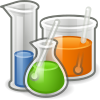| Part of a series on |
| Chemistry |
|---|
 |
The following outline acts as an overview of and topical guide to chemistry:
Contents
- Summary
- Branches
- History
- Chemicals
- Atomic theory
- Thermochemistry
- Terminology
- Thermochemical equations
- Chemists
- Chemistry literature
- Lists
- See also
- References
- External links
Chemistry is the science of atomic matter (matter that is composed of chemical elements), especially its chemical reactions, but also including its properties, structure, composition, behavior, and changes as they relate to the chemical reactions. [1] [2] Chemistry is centrally concerned with atoms and their interactions with other atoms, and particularly with the properties of chemical bonds.